Introduction
In a world of farming, house building, weaving, leatherworking, bronze smelting and flint knapping, the existence of children has often been easy to forget. And yet, ethnographically, we know that children may be involved in all of these processes. Furthermore, age relations are a significant structuring principle in many societies—affecting the actions that are deemed appropriate for different people and their own understanding of their place in the world. Hence, in response to Grete Lillehammer's (Reference Lillehammer1989) initial challenge, the methodological and theoretical underpinnings of an ‘Archaeology of Childhood’ have developed, and a wider ‘Archaeology of Age’ is now on the horizon (e.g. Appleby Reference Appleby2010; Reference Appleby2018). However, childhood studies are still poorly integrated with the mainstream discipline (Lillehammer Reference Lillehammer2015) and often appear in specialist journals or edited volumes. The investigation of childhood has flourished particularly in historical periods, when textual records, depictions and material culture unequivocally associated with children can be identified. For prehistoric periods, this interest has been more subdued (though see e.g. Derricourt Reference Derricourt2018; McLaren Reference McLaren, Gibson and Sheridan2004; Reference McLaren2011; Sánchez Romero Reference Sánchez Romero2017; Reference Sánchez Romero, Crawford, Hadley and Shepherd2018). This is particularly curious given the attention paid by prehistoric archaeologists to issues of social structure, identity and personhood.
This article focuses on childhood in the Earlier Bronze Age of Ireland and by so doing demonstrates that children can be included in our narratives of prehistory even where direct evidence of their presence is difficult to identify. Despite a huge interest in social lives in the Bronze Age of northwest Europe (e.g. Brück Reference Brück2004; Reference Brück2006; Reference Brück2009; Reference Brück2019; Crellin Reference Crellin2017; Fowler Reference Fowler2016; Reference Fowler2017; Wilkin Reference Wilkin2011), there has been little attempt to differentiate children in this milieu (though see Gibson Reference Gibson, Gibson and Sheridan2004; McLaren Reference McLaren, Gibson and Sheridan2004; Reference McLaren2011). In an Irish context, little has been attempted since cursory explorations in the 1990s (e.g. Finlay Reference Finlay2000; Mount Reference Mount1997; Ó Donnabháin & Brindley Reference Ó Donnabháin and Brindley1989/90), despite the wealth of potential data generated by excavations and osteologists in subsequent decades. As such, the time is now right for a reconsideration of children in Earlier Bronze Age Ireland and to begin to think about the broader structures of age ideology which affected individuals’ lives.
Childhood and the Bronze Age
It is now well established that age categories are culturally contingent (Hodson Reference Hodson2019; Kamp Reference Kamp2001). Children make up a large portion of any society and are likely to be bound up in wider power strategies and socio-political systems (Schwartzman Reference Schwartzman2005), though these manifest in different ways, and we cannot assume that meaningful separation between adults and children existed in every society (Bird-David Reference Bird-David and Coşkunsu2015). Where such a split does occur, adults and children are obviously symbiotic and therefore must be studied together (Kamp Reference Kamp2005). In other words, a poverty in our understanding of childhood represents a greater poverty in our understanding of the functioning of society and the lived experiences of its participants. Though an ‘Archaeology of Childhood’ was first proposed in 1989 (Lillehammer Reference Lillehammer1989), more than a decade later Kamp (Reference Kamp2001) and Baxter (Reference Baxter2005a) could still lament the lack of research. However, increased attention in the last 10–15 years (e.g. Baxter Reference Baxter2005b; Coşkunsu Reference Coşkunsu2015; Crawford et al. Reference Crawford, Hadley and Shepherd2018; Derricourt Reference Derricourt2018; Hodson Reference Hodson2019; Mays et al. Reference Mays, Gowland, Halcrow and Murphy2017) means that this is no longer the case (Baxter Reference Baxter2019; Kamp Reference Kamp2015).
Yet the focus on children is still a niche interest, often pushed to the side or ignored in wider analyses or social models (Hinson Reference Hinson2018, 23; Kamp Reference Kamp2015; Lillehammer Reference Lillehammer2015). Perhaps this is because children within our own worlds belong to the private and domestic spheres (Kamp Reference Kamp2001), with little ability to affect life outside the home. The vociferous reaction from some, men in particular, to the attention given to Greta Thunberg in debates surrounding climate change is just one particularly prominent example. Even among archaeologists who study childhood this perception had to be challenged—initial research on play, for instance, focused on this as a training for the real world to come (e.g. Baxter Reference Baxter2005a,c; Kamp Reference Kamp2001), while more recent work argues that play is an important part of the present community, forming an arena for challenge/questioning and a potential locus for change (Lancy Reference Lancy2015; Sánchez Romero Reference Sánchez Romero2017) as well as seeing childhood as just one element in a person's longer story of becoming (Hinson Reference Hinson2018). It is also the case cross-culturally that children can be involved in many productive areas within societies (Baxter Reference Baxter2005c), from active labour to care of younger children to producing change (Hinson Reference Hinson2018).
Rites of passage often relate to stages in the child's development and these can bring into focus a society's understandings of ageing and adulthood (Kamp Reference Kamp2001). We can also expect other fundamental divisions in society, such as gender or class, to come into focus around these transitions (e.g. Sofaer Derevenski Reference Sofaer Derevenski2000). Furthermore, adult lives are intricately bound up with those of children. As a result, a focus on motherhood in the past has recently developed (e.g. Beausang Reference Beausang2000; Reference Beausang2005; Bolen Reference Bolen and Claassen1992; O'Donnell Reference O'Donnell2004; Rebay-Salisbury Reference Rebay-Salisbury, Cooper and Phelan2017a,Reference Rebay-Salisbury, Keller and Wingerb; Rebay-Salisbury et al. Reference Rebay-Salisbury, Pany-Kucera, Spannagl-Steiner, Kanz, Galeta, Teschler-Nicola and Salisbury2018; Wilkie Reference Wilkie2005), though fatherhood is often overlooked (Lillehammer Reference Lillehammer2015), despite the fact that it is more culturally variable (Hrdy Reference Hrdy2009, 162; Lancy Reference Lancy2015, 144). Perhaps more interestingly, ethnographically the care of very young children is often a job for 6–10-year-olds (Kamp Reference Kamp2001; Lancy Reference Lancy2015; Whiting & Edwards Reference Whiting and Edwards1988). Thus, we should also look to children as potential providers of care, although we cannot assume a caring or nurturing attitude towards children pervaded the cultures of the past. Many societies cross-culturally practise forms of infanticide and delay the recognition of personhood (see Lancy Reference Lancy2015, 30–51) and this has also been argued to have been the case for some societies in the past (e.g. Eriksen Reference Eriksen2017).
As with gender (Butler Reference Butler1990; Sørensen Reference Sørensen2000), childhood is a cultural construct (Baxter Reference Baxter2005c; Hodson Reference Hodson2019; Kamp Reference Kamp2001) which is ‘complicated by biological factors’ (Kamp Reference Kamp2005, 116): it is a social phenomenon which is intricately tied up with physical bodies, which are the focus of mortuary practice. What was done with a body after death is revealing of how that person was considered and understood by the gathered community. Of course, the corpse itself affected those understandings—for the mourners must have taken actions appropriate for that ‘type’ of body (Brownlee Reference Brownlee2020; Haughton Reference Haughton2018). Therefore burials reflect the remembrance of children through the lens of a community's shared ideals of childhood (Baxter Reference Baxter2005c). Crucial for us, then, is the comparative—in what ways the treatment of particular bodies differed from, or was similar to, the general norm. This is our ‘way in’ to considering childhood.
Archaeological research into childhood has particularly flourished in areas and times with surviving written records (Baxter Reference Baxter2005d), something which is lacking for the Irish Bronze Age. Indeed, at first glance there is scant evidence for childhood in Earlier Bronze Age Ireland. The settlement record is not extensive, nor does it give a clear idea of patterning that can be related to any activities, let alone those of children (Cleary Reference Cleary2007, 301). Baxter (Reference Baxter2005c, 47–9) identified miniaturization, poor/expedient construction and distribution patterns differing from those of other objects as hallmarks of toys. From a similar logic, the occurrence of miniature versions of funerary pottery types had raised prospects of a material culture that was particular to, or particularly associated with, children, but an analysis of these occurring in graves has shown that no such correlation exists (Ó Donnabháin & Brindley Reference Ó Donnabháin and Brindley1989/90). We seem to be limited, then, to how children appear in graves, an arena in which they can ‘unquestionably be seen’ (Whittlesey Reference Whittlesey and Kamp2002, 152), even if that is a complicated sight. However, this may prove quite a fruitful avenue for discussing children's relationships and lives within the wider community, because it is that community which constructed the grave.
Despite the attention given to Earlier Bronze Age burials in Ireland (e.g. Brück Reference Brück2004; Mount Reference Mount1991; Reference Mount, Waddell and Shee-Twohig1995; Reference Mount1997; Waddell Reference Waddell1990), little has been made of children. As well as noting that there was no link between miniaturized funerary pottery and children, Ó Donnabháin and Brindley (Reference Ó Donnabháin and Brindley1989/90) argued that grave goods may not have appeared regularly with children aged less than 12–14 years. Charles Mount's (Reference Mount1991; Reference Mount, Waddell and Shee-Twohig1995; Reference Mount1997) wider analyses of burials in Leinster included some mentions of children, wherein he argued that c. 20 per cent of the buried population were subadults and that they occurred more commonly in multiple burials than other age groups (Mount Reference Mount1997, 160–62). His use of antiquarian descriptions of skeletons should give us pause to question these figures (see below). Nevertheless, this became the basis for descriptions of children as underrepresented in the burial record and thus not full members of society (e.g. Cooney & Grogan Reference Cooney and Grogan1999: 108; Waddell Reference Waddell2010), as has been argued elsewhere for Copper Age (Turek Reference Turek and Pavlů2000) and Bronze Age Europe (Muskett Reference Muskett2009). This was reinforced by Finlay's (Reference Finlay2000) recognition of a propensity to bury infants in fringe locations throughout Irish (pre)history, beginning in the Neolithic and continuing to the Early Modern period. Subsequently, Bronze Age children have almost dropped out of view. Perhaps, because we reason that they were not full members of society, we imagine that they cannot have been an important part of it?
Bronze Age childhood has been the focus of a similarly slight number of studies in Britain. Small et al. (Reference Small, Bruce and Shepherd1988) argued that children were also underrepresented in Scotland, but that when they were buried this was in the same way as adults; while McLaren (Reference McLaren, Gibson and Sheridan2004) saw the burial of a child with ‘rare’ grave goods as an indication of inherited status. Elsewhere in Europe, differences in grave goods for Bronze Age children have similarly been taken to represent status differences in life (e.g. Sánchez Romero Reference Sánchez Romero, Crawford, Hadley and Shepherd2018). In a wider study, McLaren (Reference McLaren2011, 84) argued that Bronze Age children in Scotland were frequently buried in multiple graves with adult females, though the acceptance of antiquarian sex determinations may have contributed to this result, and that children were often associated with smaller pottery vessels in the grave (McLaren Reference McLaren2011, 249). However, Gibson (Reference Gibson, Gibson and Sheridan2004) suggests that this relationship did not extend to the deposition of miniaturized vessels with children, as Ó Donnabháin and Brindley (Reference Ó Donnabháin and Brindley1989/90) found for Ireland. In Copper Age Bohemia and Moravia, grave good associations amongst children in Corded Ware communities seemed to match the patterns established for gendered adults, suggesting that gender was an important part of the construction of childhood too (Turek Reference Turek and Pavlů2000), though this sort of strongly gendered burial is lacking from Ireland (Haughton Reference Haughton2020).
We have, then, a hint of Bronze Age childhood in Ireland, though it has perhaps led us to reject children as an important object of study. To widen our understanding, a database of recently analysed skeletons (those with an osteological report conducted or published since 1990) was constructed and analysed. This contained the remains of 438 individuals, 288 adults, 111 subadults and the rest unknowns, from across the island of Ireland dating from throughout the Earlier Bronze Age (c. 2200–1500 bc). The results of a wide-scale analysis of this dataset follow, allowing an investigation of broad trends within the data. If children are underrepresented in the burial record, this should emerge here. Broad patterns relating to the treatment of children should also emerge at this scale, though the Bronze Age burial record in Ireland is largely lacking obvious patterning, so we might expect these to be subtle affairs.
As childhood is contextual and locally dependent, and because significant variations in Bronze Age burial traditions are known to exist (Waddell Reference Waddell1990), a discursive analysis of practice at key sites will supplement the broader-based analysis. This allows a closer look at how the wider trends relate to practice at the local level and the identification of patterns in practice which may otherwise have been overlooked. A similar analysis for gender (Haughton Reference Haughton2018) has proved fruitful in this regard. At this scale, we might expect local patterns of action to emerge which would be impossible to recognize in a population overview, but which may adhere to the bodies of children and thus inform us of attitudes towards children held by the community responsible for burying in that particular place.
Childhood: seen in the population
As we have seen, the rate at which children were buried has formed the basis for a belief that they were not considered full members of society. The use of modern osteological analyses allows this argument to be firmly tested. With unknowns excluded, the data reveal that subadults made up 28 per cent of the buried population (Table 1). It is difficult to know what proportion of the population we should expect to have died during childhood. Chamberlain (Reference Chamberlain and Sofaer Derevenski2000, 207–8) has suggested that as many as 50 per cent of some prehistoric populations may have died in childhood, while estimates based on modern ethnographic data range from 20 per cent to 56 per cent (Hewlett Reference Hewlett1991, 8). An uneasy compromise of 30 per cent for attributing underrepresentation to archaeological populations has been tentatively adopted (Lewis Reference Lewis2007, 22). The proportion here falls just below Lewis's estimate and, given that taphonomic factors are likely to affect immature skeletons differentially and that children's burials are less likely to be noticed while ploughing, we might suggest that there is little evidence that children were often excluded from burial. Even if we follow a model closer to 50 per cent infant mortality, a significant number of children are still appearing in the burial record. It seems untenable to argue that they were only buried when adults had died concurrently (contra Cooney & Grogan Reference Cooney and Grogan1999, 108; Mount Reference Mount, Waddell and Shee-Twohig1995). That this proportion is c. 50 per cent larger than that identified by Mount (Reference Mount1991; Reference Mount1997) is likely a result of improved standards of excavation, reporting and osteological analysis in these largely more recent investigations. This problem with the use of legacy data clearly has wider ramifications for studies of other aspects of social ideology, such as motherhood or gender.
Table 1. Demographic breakdown of burials in the corpus.
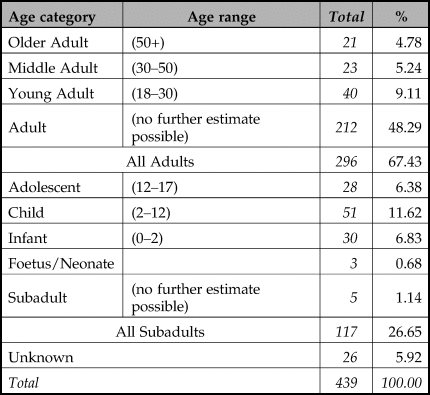
If subadults were reasonably likely to be placed in burials, then the next question is what kind of burials these were, for it has been previously noted that children were often buried with adults. It might surprise us, then, to find that multiple burials were the most common form of burial for both adults and subadults, though they were certainly more common for the latter (Table 2). It is important to note, however, that c. 25 per cent of subadults were buried in single graves, a number that must be accounted for. The tendency to be buried singly seems to increase with advancing age amongst subadults, though there is a hint that the reverse was true for adults (the low number of aged adults makes this difficult to verify). A caveat must also apply here: among a mixed burial, it is easier to identify subadults of different ages than multiple adults, because the latter relies on element duplication rather than simple size differences. Therefore, in cists with high populations, such as Tomfarney, Co. Wexford (MNI: 17) or Altaghaderry, Co. Donegal (MNI: 11), adults may be under-counted. Multiple burials most commonly combined the bodies of adults and subadults (Table 3), though 36 per cent (31 of 85) only contained the bodies of adults. On the other hand, just one or two (depending on whether an adolescent should be considered a subadult) contained only the remains of subadults. We will examine one of these cases, at Edmondstown, Co. Dublin, below. A third multiple child burial at Ballynacarriga, Co. Cork, will also be discussed, though this dated to the Late Neolithic/Early Bronze Age transition.
Table 2. The age profile of those buried in single (S/Sngl) and multiple (M/Multi) graves, with 20 unknowns excluded. (p-value refers to ‘All Adults’ against ‘All Subadults’).
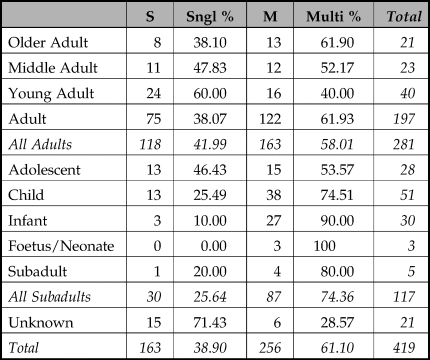
p-value = 0.002105*
Table 3. Demographic summary of multiple burials.
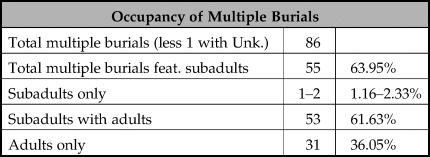
The rite afforded to the dead may have been one of the easiest and most obvious ways of differentiating between people in death, as it has a profound effect on the funerary proceedings prior to deposition. Over the totality of the period, cremation was the preferred rite for both adults and children (Table 4). A slightly lower incidence of cremation amongst adolescents is probably the result of the cremation process confounding accurate ageing—age markers may have been largely destroyed and the individuals counted simply as ‘adult’. The same process can be seen in the adult age categories, where each specific age group is much less likely to be cremated than those who could not be given a specific age.
Table 4. The age profile of those cremated and inhumed in Ireland. Crem = Cremated, CP = token Cremation, Inh = Inhumed, IP = token Inhumation.
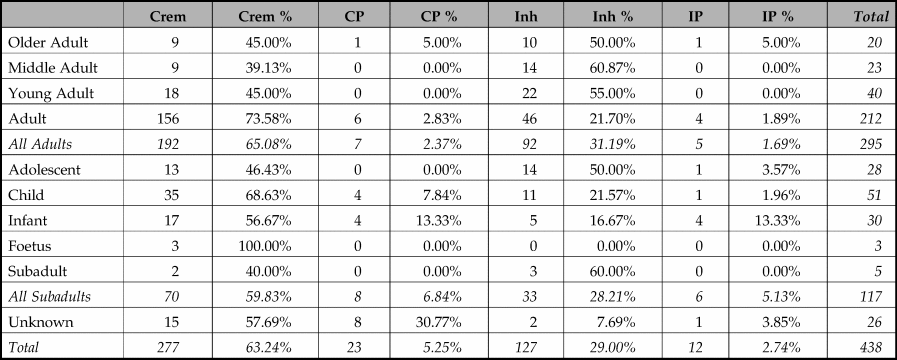
Another significant decision taken by the community was whether burial was conducted in a stone-built cist or a simple pit. The effort required to build a cist has been argued as a mark of higher status (e.g. Mount Reference Mount, Waddell and Shee-Twohig1995, 99–100; Reference Mount1997, 135–6), although some cemeteries featured only one grave type, which does not suggest differentiation. It is surprising, then, that subadults were significantly more likely than adults to be buried in cists (Table 5). This may be a factor of preservation increasing the likelihood that subadult remains survived, though a comparative Scottish sample saw adults and subadults equally likely to be buried in cists (Haughton Reference Haughton2020), suggesting a Bronze Age reality for this trend and undermining any simple equation of cists with status.
Table 5. The age profile of those buried in cists and pits. (p-value refers to ‘All Adults’ and ‘All Subadults’ with ‘Unknowns’ excluded.)

p-value = 0.009286*
Finally, let us turn to the provision of grave goods, which has often formed the backbone of social analyses of burials. Overall, there was no significant difference between the rate at which adult and subadult graves were provisioned with grave goods (Table 6), contrary to the suggestion of Ó Donnabháin and Brindley (Reference Ó Donnabháin and Brindley1989/90). Amongst the types of grave goods, there were similarly no significant differences in many of the categories, though adolescents seem to have been slightly more likely to have been buried with worked stone. The principal difference comes with the provision of metal. No subadult in the ‘infant’ or ‘child’ categories was buried with metal, though four adolescents were. There are some examples from outside this dataset where younger children were buried in a grave that contained metal, such as in the complicated and as yet unpublished series of activity in cists at Carrig, Co. Wicklow (Grogan Reference Grogan1990), but this dataset suggests that it was very uncommon.
Table 6. Summary of age groups associated with each major type of grave good. The total available for analysis varied slightly for each grave good type due to discrepancies in field recording, thus percentages relate to the total available rather than the total in the database.
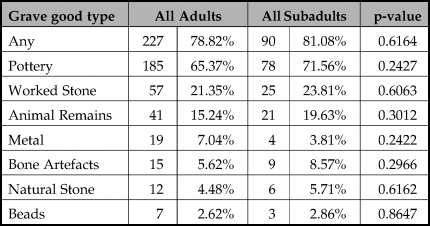
Taken together, these trends offer some hints of difference between adults and subadults broadly construed, most strikingly regarding the provision of metal to adults/adolescents, the increased likelihood for subadults to be buried in cists and their lower occurrence buried singly. However, there is quite little for us to go on here in terms of unpicking the age structures of society. I next want to turn to two case studies which might enlighten our investigation and give us real-world examples of the kind of sites from which these trends originate. I will return to the wider trends later.
Case study 1: Edmondstown, Co. Dublin
The rarity of burials containing multiple children but no adults was highlighted by the population overview. The one certain case of this, at Edmondstown, may prove an interesting case to dwell upon as we consider the post-mortem treatment of children in its local setting. This cemetery, at the foot of the Wicklow mountains in south Co. Dublin, was excavated in 1950 under the direction of P.J. Hartnett, but due to his untimely death was only brought to publication in the 1990s (Mount et al. Reference Mount, Hartnett and Buckley1993). Like many Earlier Bronze Age cemetery sites, it lay just off the brow of an esker ridge, and the views from the site would have taken in the mountains rising to the south. Dublin Bay, 8 km to the east, may also have been visible, though tree cover may have obscured this.
The cemetery itself was found to contain at least four cists and 17 pit burials (Fig. 1), though there is some discrepancy between the written records, the plans and the material which ended up in the National Museum. The discussion here is based on Charles Mount's reconstruction of the record for publication (Mount et al. Reference Mount, Hartnett and Buckley1993); the burial evidence is summarized (and see Table 7), while full detail can be found in the published report.
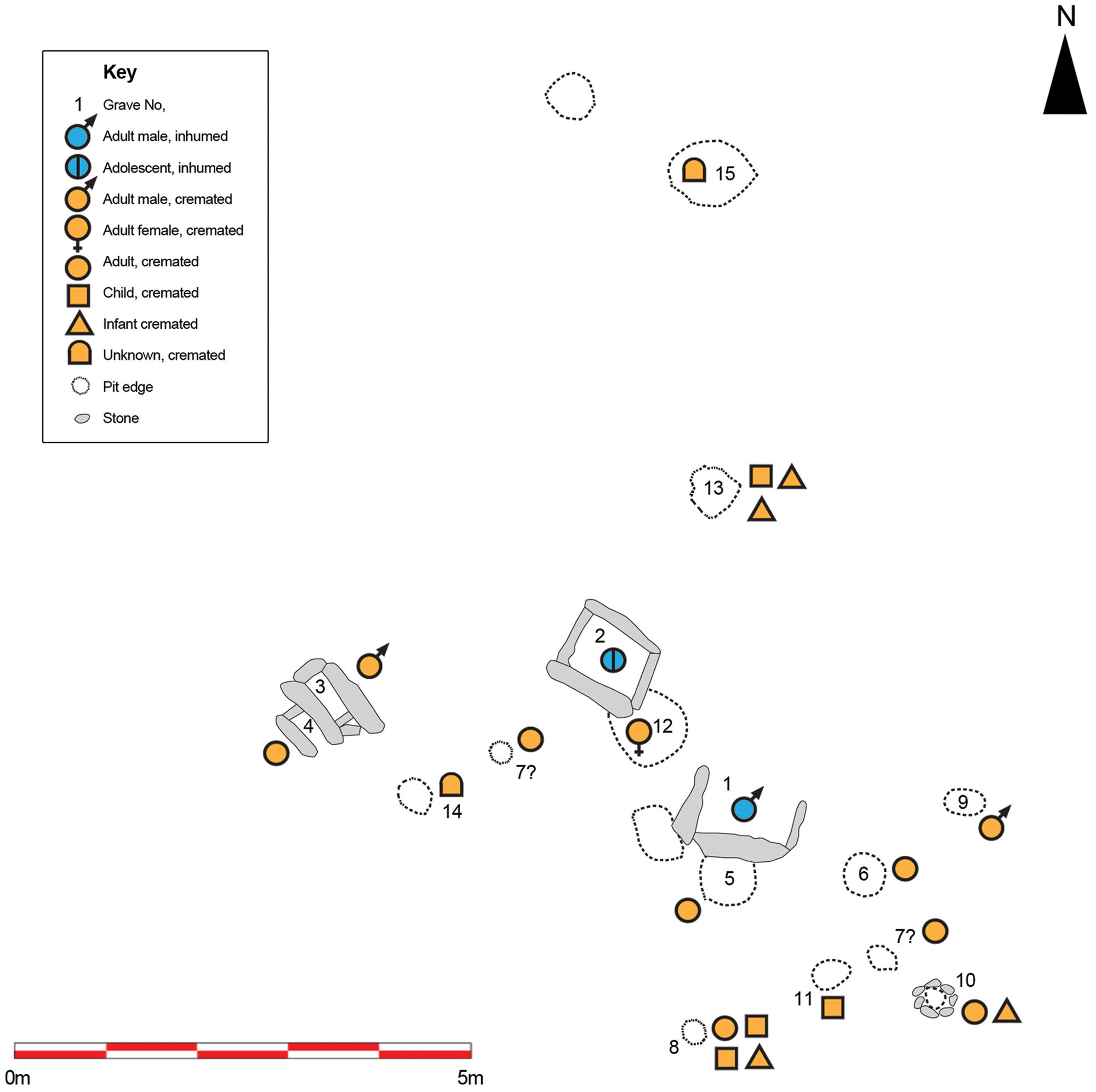
Figure 1. Simplified plan of the cemetery at Edmondstown, Co. Dublin, including demographic information on the occupants of the graves. Burials are renumbered for simplicity. (Redrawn after Mount et al. Reference Mount, Hartnett and Buckley1993, fig. 2.)
Table 7. Summary of burial evidence from Edmondstown, Co. Dublin.
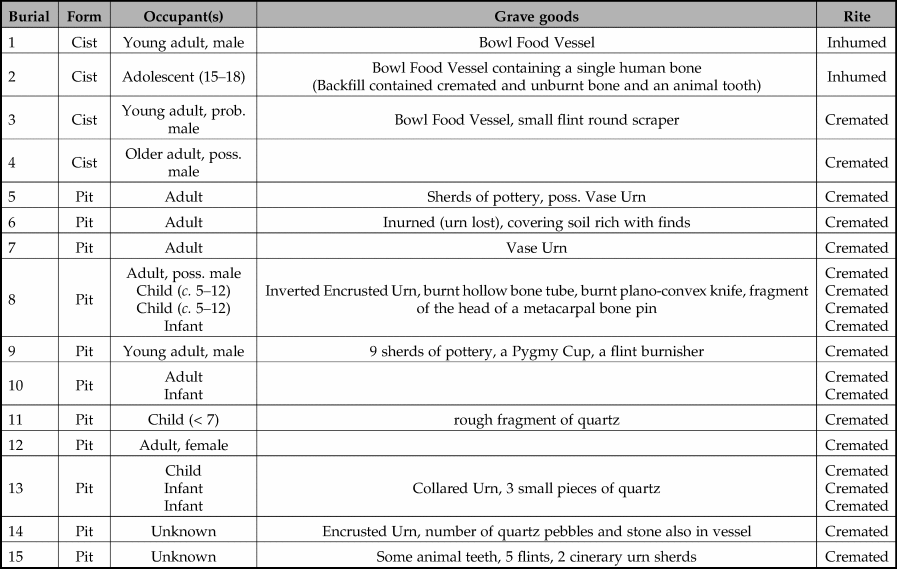
The cists were clustered together in the central area of the cemetery, with several pit burials either overlying or abutting them, showing that they were later additions. In several ways the cists shared features: their orientations were similar; Graves 3 and 4 were built together and covered by a single capstone; and each contained the remains of a single individual, all adults except for an adolescent (aged 15–18) in Grave 2. Bowl Food Vessels accompanied the burials in Graves 1–3, lying in front of the faces of the only two inhumations in this cemetery (Graves 1 and 2).
As previously mentioned, these cists attracted satellite burials. Apart from those on the plan, two burials from which the finds have not survived are worth noting: one a cremation overlying the southwestern corner of Grave 1, the other a pit burial or cremation scatter which appears on the plans overlying the west of Grave 2. For this reason, and the early currency of Bowl Food Vessels, Mount et al. (Reference Mount, Hartnett and Buckley1993, 61) suggest that the cist burials were the first activity here, and that the pit burials were later additions.
The remaining burials were mostly to the southeast of the cists (Graves 6, 8, 9, 10 and 11). The soil in this area was rich in sherds, of up to five vessels, and also included a flint end scraper and three stone disc-shaped beads, none of which were associated with a burial as traditional grave goods. Grave 7, the cremation of an adult within a Vase Urn, may have been located within this group or closer to Graves 3 and 4 (see Figure 1); two burials were labelled similarly during the excavation and the finds from one were subsequently lost.
Three further burials were identified north of the cists. A cremation associated with two flint finds was the furthest north, but it was not located in the museum's stores. The other two were pit burials, one containing cremated human bone which could not be further identified (Grave 15) and the other containing a child and two infants (Grave 13); it is this multiple burial which most concerns us here.
It is clear that adults generally predominated in these graves, though subadults occurred in three multiple burials (Graves 8, 10 and 13) and two single burials—the adolescent in Grave 2 and a child, aged about 7, in Grave 11. If the cist burials were the earliest activity here, as seems likely, it is interesting that they featured single burials. In the three adult cases, the bodies were sexed male to varying degrees of certainty (see Table 8). That the fourth single individual was an adolescent (aged 15–18) suggests that this body could fulfil the same role in burial as the adults buried nearby, and thus this person may have been considered socially to be an adult.
Table 8. Summary of burial evidence from Ballynacarriga, Co. Cork. For details of radiocarbon dates, see Lehane et al. (Reference Lehane, Johnston, Leigh, Johnston and Kiely2019).
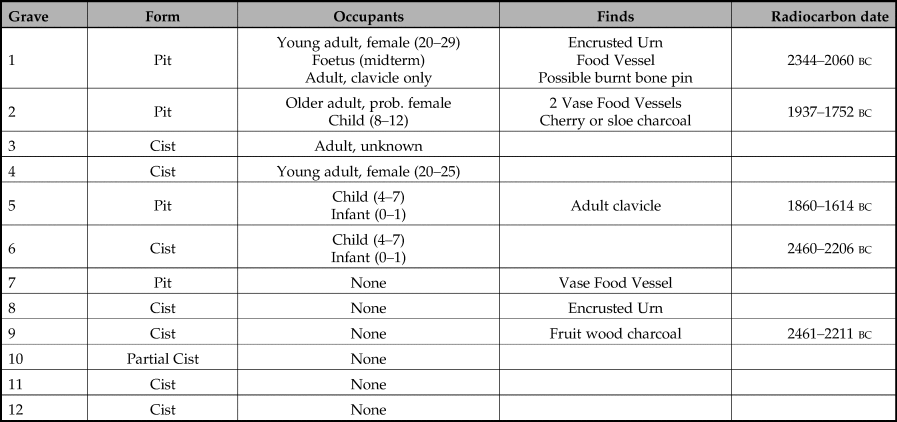
In its earliest form, then, this cemetery may have been a space associated most closely with the burial of adults, potentially adult males in particular. These burials then became a focus for subsequent activity with cremations deposited both directly beside them and at a slight remove. Mount et al. (Reference Mount, Hartnett and Buckley1993, 61) speak of this as a ‘downgrading’, but there is no need to consider these burials as particular markers of status. Instead, burial here achieved something; in each case the newly buried was tied into the narrative of this place and a conceptual interaction with the earlier burials. Indeed, the ability to inter the dead next to these early burials may enable a shift in the space's character, from one primarily associated with masculinity to one in which the whole community was represented.
The focus on individual burial here was maintained through time, though any association with males seems to have faded away. Multiple burials were reserved for cases where an adult was buried with children, which happened in two instances, and for Grave 13. Despite their different numbers, the two burials without adults are quite striking: a single child in Grave 11 and the child with two infants in Grave 13. In both cases, quartz accompanied the deceased in the grave. In Grave 13, the three subadults were accompanied by three small pieces of quartz. The child buried alone in Grave 11 was accompanied by a single piece of quartz. In each case, the number of quartz pebbles matched the number of individuals in the grave. The only other use of quartz was in Grave 14, a grave with just 25 g of indeterminate crushed bone. It does not seem a coincidence that the community only chose to deploy quartz in the grave when children were buried without adults, nor that the number of quartz pieces corresponded to the number of children in the grave. Therefore, it is possible to suggest that quartz played a role when children were to be buried alone, potentially serving an apotropaic function in the place of an adult. Quartz may have possessed a quality which it either shared with adult bodies or which made up for something which the subadult bodies lacked. Perhaps the first instance where quartz was used in this way was deemed successful and it was then repeated, potentially on two occasions, reinforcing an understanding specific to this place of the proper way to treat a child which was not shared amongst a broader community. We will return to these possibilities later.
Case study 2: Ballynacarriga, Co. Cork
The discussion next takes us to a site featuring several burials containing subadults in the southwest of the island. The site at Ballynacarriga, Co. Cork, was excavated as part of the N8 Fermoy–Mitchelstown Bypass (Lehane & Leigh Reference Lehane and Leigh2010). As was the case for the discussion of Edmondstown, I here rely on the excavation report (Lehane & Leigh Reference Lehane and Leigh2010) and published report (Lehane et al. Reference Lehane, Johnston, Leigh, Johnston and Kiely2019), and further detail can be found therein.
Two ring-ditches were excavated (Fig. 2), just south of an enclosure which contained structures and pits producing Middle Neolithic, Late Neolithic and Beaker pottery. The association may be fortuitous, or the location of this cemetery may have been a response to this earlier activity. As with many Earlier Bronze Age cemeteries, it was set in a locally prominent location with wide panoramic views; it was bordered to the north by a sharp drop to the Glencorra stream and to the west by the River Funshion 300 m away. The surrounding landscape was fairly densely populated with Bronze Age burials, reminding us that mourners probably frequently made choices about where to place the dead from a range of possibilities.
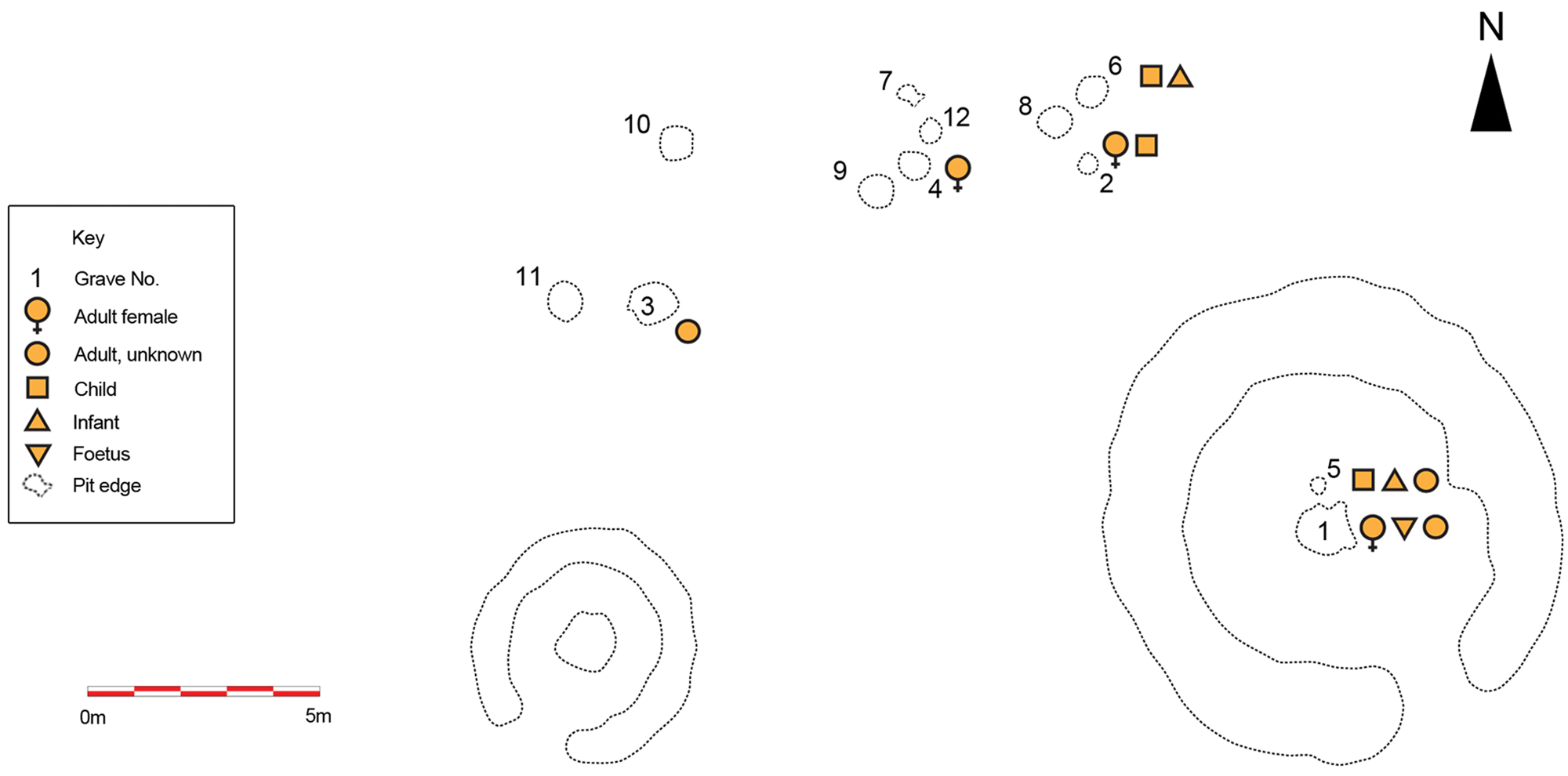
Figure 2. Simplified plan of the cemetery at Ballynacarriga, Co. Cork, including demographic information on the occupants of the graves. Burials are renumbered for simplicity. (Redrawn after Lehane & Leigh Reference Lehane and Leigh2010, fig. 6.)
The western, smaller ring-ditch contained evidence of burning, but no burial or pyre site was identified there. The larger ring-ditch, however, was found to encircle several pits with evidence of burning and two burials. In the first (Grave 1), the cremated remains of an adult female and a foetus in the second trimester of development were deposited, along with the clavicle of an older adult within an Encrusted Urn. The second grave (Grave 5) within the ring-ditch had clearly been recut and only a small amount of cremated bone remained: these were from two subadults, an infant (aged 0–1) and a child (aged 4–7). This burial was also accompanied by a clavicle from an adult.
To the north of this ring-ditch, a series of nine cists and a pit were uncovered. Within one of these (Grave 6) were the cremated remains of an infant and a child of the same ages as those in Grave 5, and with no recurring elements between the deposits. The osteologist considered it likely that these graves represented the same two subadults—originally buried within the ring-ditch and later dug up and reinterred in the cist (Lehane & Leigh Reference Lehane and Leigh2010, 276). However, a radiocarbon date for Grave 6 is much earlier than anticipated (see Table 8) and suggests this feature was not contemporary with Grave 5. Furthermore, a radiocarbon date for the Encrusted Urn-associated Grave 1 was also anomalously early (see Lehane et al. Reference Lehane, Johnston, Leigh, Johnston and Kiely2019, 45–7). An old wood effect may have produced this discrepancy, or these remains may truly have been older than the pottery and represent reburied material from earlier burials in the cist group (Carlin Reference Carlin2018, 113–14).
Three of the other features in the northern area contained cremated remains (Graves 2–4), while the others suggest different uses (summarized in Table 8). This was clearly a site with a complicated history of use extending back to the Late Neolithic, only some of which concerned explicit burial practice. Some of the cists may have held burials which were subsequently removed, as seems to have happened with Grave 5, but others may have seen other forms of deposition or activity. The possibility remains that these other actions were also concerned with remembering the dead.
The subadults within this cemetery were again buried in multiple graves: a child with an older adult female in Grave 2; the child and infant buried together in Grave 5; and that combination foreshadowed in the earlier Grave 6. The inclusion of an adult clavicle in Grave 5 is immediately striking, both because it mirrors the practice in Grave 1 and because it ensured that these subadult remains were accompanied by at least part of an adult, mirroring the concern which was hinted at in Edmondstown. It has long been recognized that the retention of human bone for later deposition was a feature of the Bronze Age in Britain and Ireland (e.g. Brück Reference Brück1995; Reference Brück2019; Cleary Reference Cleary2005). Remarkable here is the repeated use of a particular bone, implying that the bone retained something of the deceased's identity in death; it seems to have mattered that this bone had come from an adult and that it was a clavicle. This pattern of selective retention has been noted at other sites (see Haughton Reference Haughton2020). Here, it acted to link these two burials, perhaps recognizing some relationship between the buried individuals, or simply drawing upon shared metaphors which were appropriate on both occasions. The deposition of this bone must have enhanced the connection between this grave and the neighbouring Grave 1, though the subsequent disinterring of Grave 5 disrupts this picture. While the burial of an infant (aged 0–1) and child (aged 4–7) in both Graves 5 and 6 may hint at other ways of remembering the combination of bodies, potentially across several centuries, this is difficult to confirm.
The selection of bone for inclusion within graves seems to have presented another opportunity for this community to mark difference and similarity through practice. The adults in this cemetery were sometimes represented by small amounts of bone (118.4 g for Grave 3; 269.7 g for Grave 4) and yet all elements of the body were represented for all four (except dentition in Grave 3). By contrast, the subadults were represented by selected bones, principally skull and long bones, with occasional vertebrae and ribs. Thus, while there was no concern with collecting all bone from the pyre, the representation of the full adult body seems to have been important in a way which was not a concern for subadults. Though, of course, potential taphonomic factors must make this a tentative suggestion.
The ring-ditch marked out a particular space, and the burial here of the adult female with foetus and an additional adult clavicle is potentially significant. The fact that this woman was seemingly pregnant when she died, and that she was buried in this place where other women and children were buried, seems noteworthy. We cannot know the sequence, whether this burial predates or postdates the other women and children, but it may have helped to define this space as one concerned with motherhood, or it may have responded to an existing association with this. The physicality of the ring-ditch, the boundary it described around this space, would concentrate the attention on that which was done within it. That Grave 5 was originally dug within it and then seemingly moved must have been redolent with meanings, though we strain to see them now. Perhaps this pregnancy, and the very idea of motherhood, was central to the construction of place and the selection of certain people for burial here. Might we even consider links between pregnancy and the interactions with the children in Grave 5? Their remains seem to have rested here for a while, gone through a transformation of some kind in this powerful place, then emerged into the world again before potential reburial elsewhere. I do not mean to argue here that there was a literal parallel between the burial and conception, the exhumation and birth; rather I mean to suggest that if this was a place which the mourners associated with pregnancy and motherhood, some of them may have considered these connections when exhuming this bone. How the mourners considered subadult bodies in the early second millennium bc was also seemingly influenced by a long history of engagement with this place—the bodies of the children buried in Grave 5 directly mirror those in the earlier Grave 6, and the burial in Grave 1 of adult and foetus may also represent a re-engagement with bone originally buried centuries before. Burial in this place thus represented a significantly different experience for the mourners than it would have at Edmondstown, likely to evoke different narratives about who the buried were, and why they were carrying out the burial.
The effects of the burial: constructing childhood
The examination of these two cemeteries has revealed different ways of marking the deaths of children which were subtle and small-scale, but specifically tied these burials into a local way of doing things. There were, then, particular ways of treating children which emerge at this scale, but which fade away at a larger scale. Quartz was not generally placed in the graves of children lacking adults, nor were adult clavicles often deployed in troublesome burials. We have, however, seen practices which suggest that children's deaths demanded particular responses: but, of course, this was not always the case. At Tomfarney, Co. Wexford, for instance, the remains of at least 17 people—adults and children—were mixed in the grave as a single deposit (Sikora & Reilly Reference Sikora, Reilly, Cahill and Sikora2011); while at Kilcroagh, Co. Antrim, six individuals were buried across four graves, but children were effectively absent from the space altogether (one adolescent was buried in a manner suggesting they were part of the adult world; see below for discussion). Thus, navigating this variety, and linking it with the wider picture, is what must occupy us in the next phase of this discussion.
From the general overview, it was possible to identify that children were commonly placed in multiple graves (74 per cent), although so were the majority (55 per cent) of adults. Thinking about bodies in terms of their relations to other bodies was, thus, a major feature of most burial practice, but particularly that of subadults. A further broad difference was identified in the rate of burial within a cist, with a higher proportion of subadults receiving cist burial than adults (72 per cent, compared to 59 per cent). This is particularly interesting given arguments that cists, which require increased effort to build, were markers of high status (e.g. Mount Reference Mount1997). It is perhaps unlikely that subadults were generally of a higher status than adults, and this acts as a caution against simple readings of status from burial treatment. Perhaps a cist was more often chosen because it offered better protection, or because it enabled access for subsequent deposition and/or the removal of skeletal elements; we are ill-equipped to judge.
The provision of metal grave goods provided an interesting picture of difference. Of the 23 skeletons buried in graves containing metal, four were adolescents and none were younger than this. Two of these adolescents were in the same grave, at Carrowntober East, Co. Galway (Mahr Reference Mahr, Cahill and Sikora2011). This grave featured an inhumation of an adolescent female (aged 14–18) and a mixed cremation of another adolescent and an adult female. As the evidence for metal was green staining upon the cremated bone, the inhumed adolescent can additionally be discounted as a recipient of metal. A third case was from Kilcroagh, Co. Antrim, a site which otherwise only featured adult burials (Williams et al. Reference Williams, Wilkinson and Magee1991/92). The adolescent male here (aged 15–16) had been cremated and his remains mixed with those of an adult female before they were buried in an Encrusted Urn. The majority of the remains were those of the adult, and the bronze dagger recovered from this grave had been ‘plunged’ into the remains after they were mixed and placed in the pot. In other words, the metal was not associated with either one of these bodies, but interacted with the remains after they had been mixed. That this burial mirrored another of a male and female within an Encrusted Urn from the same site suggests that this adolescent male was incorporated in an ‘adult’ rite. The final case was the famous so-called ‘Tara Boy’ (aged 14–15, from Tara, Co. Meath), who had made a journey that involved long-distance travel, perhaps to southern Britain (Sheridan et al. Reference Sheridan, Jay, Montgomery, Pellegrini, Wilson, O'Sullivan, Scarre and Doyle2013), and was buried with a necklace, a bronze razor and a possible bronze awl in what was potentially the closing act of the Mound of the Hostages cemetery at Tara (O'Sullivan Reference O'Sullivan2005). These cases suggest that metal was rarely associated even with adolescents, and that when it was it seems to have been as part of ‘adult’ rites. It is wholly possible that some of these adolescents, on the cusp of puberty, may have been socially considered adult.
The rare occurrence of children in a multiple grave without an adult led us to the site of Edmondstown, where we encountered subadults who had been buried with adults, or with a piece of quartz, but not with both. This suggests a role for adults within these graves which could equally be fulfilled by quartz, perhaps because it was considered to have some power or quality which an adult also possessed, whether protective or otherwise. The lustrous nature of quartz may have aided its identification with these special qualities. Either way, this is a specific local practice concerning the burial of children, which seems to respond to an occasional problem of having no adults available to bury with children. The local dimension of this concern is worth stressing: what seems to have elicited a particular response at Edmondstown was clearly not considered to be a problem elsewhere, as evidenced by the 26 per cent of subadults buried singly.
Children were also at the centre of practice at Ballynacarriga, where links with pregnancy and/or motherhood seem to have been particularly prominent. Both Grave 1 and Grave 5 contained an adult clavicle alongside the other remains. These acts tied these burials together, as did the burial of similar types of bodies in Graves 5 and 6. The later burial in the centre of the ring-ditch (Grave 5) placed these children within a particular space, linking them to the already unfolding story of activity here. Indeed, these burials, of pairs of children and of a pregnant woman, may represent the most ‘troublesome’ burials here, perhaps requiring the extra response afforded by the inclusion of an adult clavicle or placement within the ring-ditch. What this might have symbolized to the gathered mourners is difficult to discern, but we can assume that it is not coincidental that the adult clavicle was used twice, and it must have played a part in the sense of place here and these children's role within it. Interestingly, a disturbed subadult's burial at Glencurran Cave, Co. Clare, dating from the Late Bronze Age, was accompanied by an infant femur and 11 adult bones, six of them clavicles (Dowd Reference Dowd, Finlay, McCartan and Wickham Jones2009).Footnote 1 While the repeated selection of the clavicle is almost certainly unrelated to practice at Ballynacarriga a millennium previously, this suggests a long-standing interest in the selection of particular bones for deposition in Bronze Age Ireland.
It was clearly possible to use mortuary practice to stress the links of adults to their community, both directly in the same grave, and by tying them into a ‘community in death’ in the cemetery itself, but it was also frequently appropriate to place adults alone in the landscape and thus to link them to topographical features or routeways. This does not necessarily mean that these people were thought of as ‘individuals’ as opposed to the ‘relational’ identities of those in larger cemeteries; rather it reflects a wider understanding of the various appropriate ways of linking these people to the world around them, only some of which were commonly used for subadults.
Conclusions
Both the general trends and the pictures of burial practice which we encountered at Edmondstown and Ballynacarriga suggest a concern with emphasizing the position of subadults within the community. However, the kinds of kinship links which encourage large-scale cemeteries to endure through time seem to have been absent from Ireland, while they were present in mainland Europe and in some of the barrow cemeteries in southern Britain. Long-term relations with the community, then, were either not important to mortuary practice, or perhaps could be achieved through a general appeal to similarity with wider burial practice. This is a radically different picture to the kind of rulebound, large cemeteries which we see in continental Europe at this time (e.g. Bourgeois & Kroon Reference Bourgeois and Kroon2017; Rebay-Salisbury Reference Rebay-Salisbury, Lillehammer and Murphy2018; Rega Reference Rega, Moore and Scott1997; Sofaer Derevenski Reference Sofaer Derevenski2000; Sørensen & Rebay Reference Sørensen and Rebay2005; Sørensen & Rebay-Salisbury Reference Sørensen and Rebay-Salisbury2008), which must have evoked ideas of long-term connection, both to that particular place and to the wider community or communities making burials there.
In Ireland, communities returned to burial places much less frequently, though as we have seen at Ballynacarriga they could still be influenced by previous practice many years later. The death of a child seems to have elicited specific responses which were more likely to stress ties to that particular community—either by burying children with adults, or by incorporating them into local traditions of practice which seem to have developed around particularly ‘troubling’ burials. This frequent emphasis on their relationships with others suggests that children were integral to communities, though the local character that this takes is different from the more formalized and rule-bound approach to burial seen elsewhere in Europe. There is not, then, an indication that subadults were not ‘full members’ of society. Rather, we might say that their membership of these societies was recognized as being of a different character. As seen through burials, childhood took on forms which stress its relational and locally contingent character. The trends for the treatment of children vary subtly across cemeteries. Thus, while a child's death may be troubling, the ways for dealing with this within the broader rules of Earlier Bronze Age burial do not seem to have been rigidly prescribed or even shared between communities.
There are no obvious divisions between types of children, nor an obvious sign of a defined point for entry into adulthood; some of the adolescents we have encountered were buried in ‘adult’ ways, but not all of them. Perhaps these dispersed, small-scale communities lack the larger number of children that might allow people to be grouped into age cohorts separated by rites of passage, as seen elsewhere in Europe (e.g. Sofaer Derevenski Reference Sofaer Derevenski2000). Instead, these burials suggest a more gradual transition from childhood ‘other’ to an adult role within the community. This may represent differences in patterns of social interaction between people in Ireland and those in other parts of Europe. Formalized social divisions between age groups or genders, and the attendant material culture to reinforce them, as identified for Copper Age Hungary (Sofaer Derevenski Reference Sofaer Derevenski2000) or Central Europe (Turek Reference Turek and Pavlů2000), attest a need for children to broadcast their identity to others. This does not seem to have been necessary at the graveside in Ireland, perhaps because all members of the community were known to one another, and concern was instead placed on incorporating these individuals within the group.
Burial itself may have been an adult arena. We might suggest that it was conducted and organized by adults; thus it may not be so surprising that it is the relationships of children to the community that were usually stressed at the graveside. The number of adults occurring in multiple graves hints that this was also true for many adults, however. It is the ‘individualized’ burials which are really rare at this time, and mark those individuals out as somehow different or ‘not of’ the community. This need not necessarily connote status, but it does suggest differences in the roles that adults and subadults could fulfil within these communities in death, and so presumably in life.
At Edmondstown, Co. Dublin, Mount et al. (Reference Mount, Hartnett and Buckley1993, 61) argued that the fact that males were buried in cists in the earliest phase of site-use demonstrated that these men were ‘at the head of their social elite’. However, there is little in the burial record to support this. The cist burials certainly were a focal point for later practice, but the fact that they were the earliest burials may be enough to explain this. We do not know that being first in a cemetery was desirable or indicative of status. How, also, do we explain the low number of grave goods in these cists compared to others at the site? Mount et al. (Reference Mount, Hartnett and Buckley1993, 61) subsequently argue that this site was then either opened up or saw a ‘downgrading’ to allow the burials of women and children. However, the quartz deployed in place of adults suggests that status was not the primary concern when these depositions were made; rather the inclusion of grave goods was intended to achieve something, in this case perhaps to embody a quality that the child lacked. Though it may, as we saw, have started out as a place associated with masculinity, this does not mean that it was a place for a hierarchical elite.
For children at the graveside, these burials must have stressed their position within society, through the importance placed on how the deceased related to the community. While suggesting that children were ‘other’ to adults, they were a type of ‘other’ that belonged in and with the community, enfolded within locally specific practices. That there were not wider discussions of how children should be treated differently perhaps suggests that this was not a broad and important cleft in society, but that distinctions were subtle, contextual and emergent.
Acknowledgements
A version of this paper was presented at the Bronze Age Forum 2019 in Durham and I thank the participants for the discussion of many of the points here. In particular, I thank Neil Carlin and Kerri Cleary for discussion of Edmondstown and Ballynacarriga. The paper arises from research conducted for my PhD at the University of Cambridge funded by the Art & Humanities Research Council (UK), Jesus College, Cambridge, the Isbel Fletcher Garden Fund and the Department of Archaeology. My supervisor Marie Louise Stig Sørensen was an excellent support on all aspects of this research and the wider project. Neil and Marie Louise kindly read earlier drafts of this paper, and I also thank two anonymous peer reviewers and the editor for perceptive comments.












